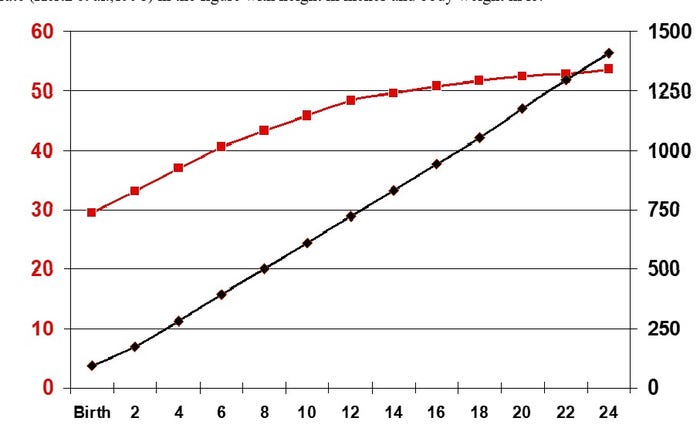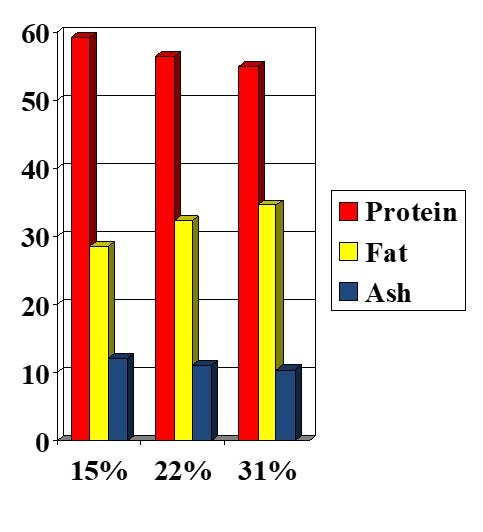Principles of growth and body composition of cattle
In order to avoid undue fattening in calves and heifers, daily gain should be limited to no more than 2.2 lb (1 kg) as that is the peak for body protein deposition.
May 27, 2022

By Dr. Al Kertz, ANDHIL LLC
The classic review on growth and body composition of cattle was published in 1955 (Reid et al.) and established some key elements:
There is an inverse relationship between body water and fat. Thus, fattening is largely a replacement of water by fat.
The percentages of water, protein, and mineral approaches constancy in the fat-free body of animals after “chemical maturity” is attained. This at that time resulted in the combination of those components being about 73%; but that constant is subject to much variation.
Carbohydrates only account for about 0.5% of the body so it can be ignored in longer term studies.
Age is highly correlated with the % of fat-free body components, and this was a curvilinear relationship.
Some of the key cattle studies cited in that review were done in the 1910s and 1930s at the University of Missouri by Waters and Mumford—2 buildings on campus are named in their honor. Then Samuel Brody did his prodigious studies and published his book in 1964 on Bioenergetics and Growth. That may have been a factor in why a major symposium was held there in May 1967 on Body Composition in Animals and Man which is available as a download at the National Academies Press: https://www.nap.edu/catalog/20255/body-composition-in-animals-and-man-procewedings-of-a-symosium
As I was dually enrolled undergraduate/graduate student there at that time, I met Dr. J. T. (Tom) Reid then as he was a speaker and organizer at that symposium. That led to my becoming one of his graduate students three years later after receiving a commission in the US Army, completing my M.S. degree, and then two years of active duty in the Army. The timing was fortuitous as he and Dr. George H. Wellington (in meats) had developed a major research project in the growth and development of cattle. We used two breeds (Angus and Holstein), three sexes (bulls, steers, heifers), 2 levels of intakes (ad libitum and 70% of that), and four body weight points (400 lb baseline, 600, 800, and 1000 lb). All animals were slaughtered and detailed body composition—both physical dissection and chemical--was measured. Other data measured were intake, daily gain, and the single diet digestibilities. I also did specialized assays for growth (Kertz et al., 1982). This study was replicated and involved graduate students from Chile (Siegfried Simpfendorfer and Rene Anrique), Colombia (Horacio Ayala), Canada (Andre Fortin and David Sims), Mali West Africa (Almouzar Maiga), and me as also the project coordinator. Some of the key findings were:
Bulls followed by steers and heifers were the most anabolic with greater protein and mineral deposition but less fat.
Holsteins had later fat deposition and more internally first than Angus.
These differences were quantitated and partly published (Fortin et al., 1980, 1981) before Tom Reid’s untimely death.
One animal especially stood out. This Angus bull had been randomly assigned to the 1,000 lb slaughter grouping on the lower level of intake. But he grew as much as his paired Angus bull mate on the ad libitum intake level. And he had the greatest protein deposition and the greatest insulin and growth hormone blood levels. If he would have had great genetic transmitting ability, he should have not been slaughtered!
So, how does this relate to growing and more mature dairy animals? First. look at a typical growth rate (Kertz et al.,1998) in the figure with height in inches and body weight in lb.

After 2 months of age, growth should be fairly linear at 1.8 to 2.0 lb daily gains. But height increase is not linear—it is more curvilinear. In fact, there are 3 segments to height increase: 50% occurs in the first 6 months, 25% in the next 6 months, and then only 25% in the entire second year. This of course relates to bone growth which can be measured indirectly by mineral deposition in the body. But that entails slaughter studies for more direct measurement. Fortunately, wither or hip (2 inch greater than wither height measurements) height is a good practical measure.
As heifers matured, the following data resulted (Kertz et al., 1997).
Lactation number | First | Second | Third |
Body weight, lb |
|
|
|
Close-up | 1343 | 1504 | 1627 |
Post-calving | 1204 | 1350 | 1464 |
Wither height, in. | 54.3 | 55.5 | 56.3 |
Calf birth weight, lb |
|
|
|
Females | 84.8 | 90.7 | 91.6 |
Males | 91.2 | 97.1 | 97.8 |
Mature body weight and height peak at about the third lactation. At calving, about 11% of body weight is lost from the weight of the calf and associated fluid and tissues. Calves weighed more after the first lactation. Male calves weighed about 7% more than female calves.
Now let’s go back to the calf growth period. Calves have limited fat at birth, maybe 3 to 5%. That is likely the lowest it will ever be, and thus the calf’s body water content is the highest it will ever be. An example of this relationship is the study by Tikofsky et al., 2001. Male Holstein calves were fed to gain about the same 1.3 lb daily when fed milk replacers isocaloric and isonitrogenous but differing in protein and fat levels. The final live body weight of 187 lb was chosen because it represents the upper weight limit that calves are fed milk replacer on most commercial dairy farms. Live body weight differed in composition as water was displaced by fat which increased from 8.5 to 11.0%. The main effect is shown in the figure below as fatter calves with less protein and mineral content resulted as fat % in milk replacers increased from 15 to 31%. This became the basis for the “accelerated” milk replacer feeding program with 28% protein and 15% fat.

This leads to the issue of undue fattening in calves and heifers. As noted above, growth is most efficient during the first 6 months. Adipose (fat) cells first increase by hyperplasia—increased number of fat cells at an early age. Fattening later occurs by hypertrophy—increased size of fat cells. If more fat cells are developed early in life, there is an increased propensity to fatten later more easily because more fat cells are present to increase in size. Growth studies in both beef and dairy animals have found daily gains over 2.2 lb (1kg) result primarily in fattening because 1 kg is when protein deposition is maximized.
But what about daily gains of 2.5 to 3.0 lb? Mike Van Amburgh told me in 2007 that “….any energy intake that allows for growth in excess of 2.2 lb per day will end up as fat -- that appears to be the upper limit for optimizing protein deposition….it is not encouraged and is usually done to overcome a bad or average calf growth program…”
The Bottom Line
When calves are born, they have low body fat concentration. As they grow and fatten, this fat displaces body water. In order to avoid undue fattening in calves and heifers, daily gain should be limited to no more than 2.2 lb (1 kg) as that is the peak for body protein deposition. Fatter calves and heifers are more likely to result in calving difficulty and metabolic issues around calving., just as it does for older cows.
References
Fortin, A., S. Simpfendorfer, J.T. Reid, H.J. Ayala, R. Anrique, and A.F. Kertz. 1980. Effect of level of energy intake and influence of breed and sex on the chemical composition of cattle. J. Anim. Sci. 51:604-613.
Fortin, A., J.T. Reid, S. Simpfendorfer, H.J. Ayala, R. Anrique, A.F. Kertz, A.M. Maiga, D.W. Sim, and G.H. Wellington. 1981. Chemical composition and carcass specific gravity in cattle: effect of level of energy intake and influence of breed and sex. Can. J. Anim. Sci. 61:871-882.
Kertz, A.F., J.T. Reid, G.H. Wellington, H.J. Ayala, S. Simpfendorfer, A.M. Maiga, and A. Fortin. 1982. Growth and development of cattle as related to breed, sex, and level of intake. 1. Plasma, insulin, and growth hormone. 2. Characterization of the chemical development and lipogenic activity of subcutaneuous, perirenal, and omental adipose tissue sites. 3. Growth and development of the liver as related to body weight, intake, chemical composition, DNA, and RNA, and lipogenic activity. 4. Growth and development of biceps femoris, longissimus, and triceps brachii muscles as related to total muscle weight, chemical composition, and DNA and RNA content. Search: Agriculture. Ithaca, NY: Cornell Univ. Agr. Exp. Sta. No. 23, 32 pp.
Kertz, A. F., L. F. Reutzel, B. A. Barton, and R. L. Ely. 1997. Body weight, body condition score, and wither height of prepartum Holstein cows and body weight and sex of calves by parity. A database and summary. J. Dairy Sci. 80:525-529.
Kertz, A. F., B. A. Barton, and L. F. Reutzel. 1998. Relative efficiencies of wither height and body weight increase from birth until first calving in Holstein cattle. J. Dairy Sci. 81:1479-1482.
Reid, J.T., G. H. Wellington, and H. O. Dunn. 1955. Some relationships among the major chemical components of the bovine body and their application to nutritional investigations. J. Dairy Sci. 38:344-359.
Tikofsky, J. N., M. E. Van Amburgh, and D. A. Ross et al. 2001. Effect of varying carbohydrate and fat content of milk replacer on body composition of Holstein bull calves. J. Anim. Sci. 79:2260-2267.
You May Also Like



